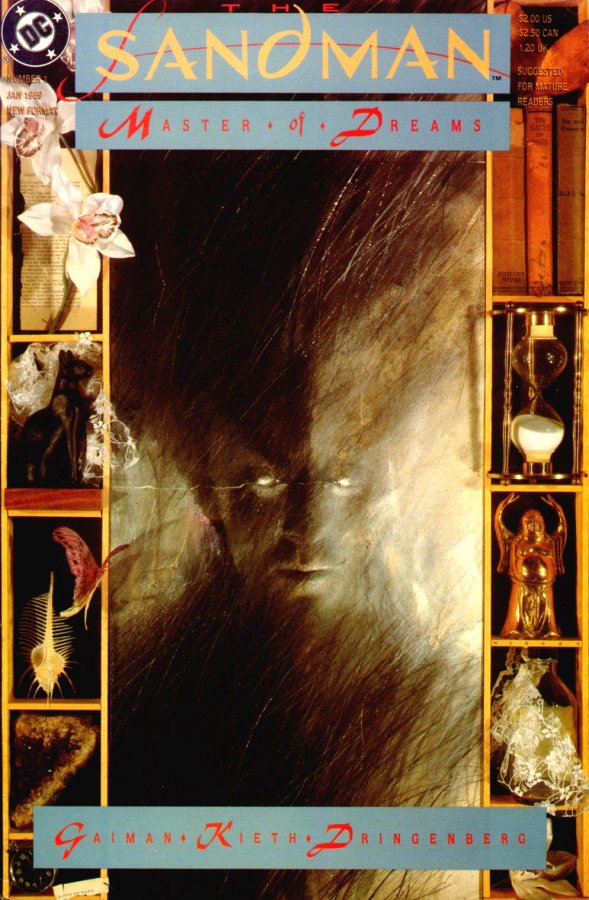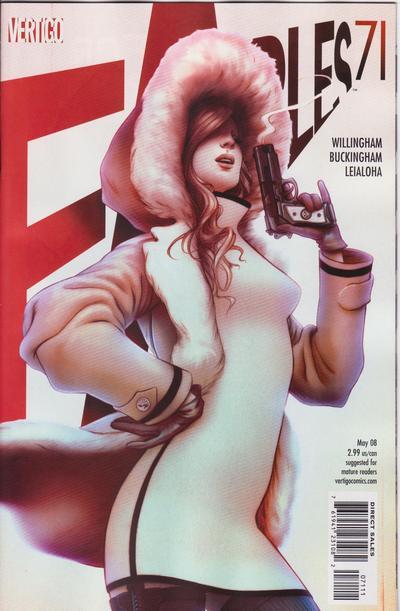I first met Karen Berger at one of the early MoCCA Festivals, back when it was still in the Puck Building, but I didn’t really have a conversation with her until the following summer, at the massive San Diego Comic-Con that year. I was hanging out with then-up-and-coming writer Jason Aaron and we were both waiting to head over to a Vertigo Comics panel, he was scheduled to attend and I was scheduled to cover it for a comic book news outlet.
I knew Karen Berger before that, but only through her astounding resume, one that, for many readers who grew up reading comics in the 1980s and into the 1990s, carved a path toward the best kinds of comics available. It’s not just that she had good taste—though that was part of it—what’s more unbelievable is that she was able to shift the direction of the comic book industry towards smarter, more literate stories. She changed the course of the entire industry.
Even before she founded Vertigo Comics—the DC imprint that has given us Fables, 100 Bullets, Preacher, Scalped, The Invisibles, iZombie, Seaguy, Human Target, Young Liars, American Vampire, Northlanders and dozens of other wonderful comics—she worked her editorial magic on some of the greatest comics ever to come out of the American mainstream. Not only did she work alongside DC-publisher-to-be Paul Levitz on his seminal Legion of Super-Heroes series, and George Perez’s Wonder Woman relaunch, but she also took over the editing of a certain Saga of the Swamp Thing comic, a few months into Alan Moore’s legendary run. At the time she was also editing Amethyst, Princess of the Gemworld, another fondly-remembered comic that was hardly the typical superhero action that DC was bombarding the market with.
 Within a few years, Berger was not only continuing to guide Swamp Thing alongside the Legion and Wonder Woman comics, but she also helped launch a few new series under her editorial eye—some books you may have heard of, like the John Constantine vehicle called Hellblazer, Grant Morrison’s American debut in Animal Man, and Neil Gaiman’s American debut in Black Orchid. That last comic was just a precursor to an ongoing series she had brewing with Gaiman. A little series called Sandman.
Within a few years, Berger was not only continuing to guide Swamp Thing alongside the Legion and Wonder Woman comics, but she also helped launch a few new series under her editorial eye—some books you may have heard of, like the John Constantine vehicle called Hellblazer, Grant Morrison’s American debut in Animal Man, and Neil Gaiman’s American debut in Black Orchid. That last comic was just a precursor to an ongoing series she had brewing with Gaiman. A little series called Sandman.
It’s tempting to say “the rest is history” and leave it at that, but that would imply that she had accomplished everything by that point and everything else as just an extended epilogue. But that’s not true at all.
Had she stopped there, with the launch of Sandman, after everything she had done before, she still would be considered one of the greatest comic book editors to have ever lived. But her career was still going strong, and she was a long way from saying goodbye.
She went on to edit the launch of Peter Milligan and Chris Bachalo’s Shade the Changing Man, and a half-dozen other weird and interesting comics from creators like Grant Morrison, Duncan Fegredo, Ken Steacy, Jamie Delano, John Higgins, Tom Veitch, and Bryan Talbot, not to mention additional work from Neil Gaiman, John Bolton, Charles Vess, and others.
Most of these creators, and some of the comics I have already mentioned, seem like quintessential components of Vertigo Comics. And that would be true, but before there was a Vertigo Comics, there was Karen Berger, editing a line of smart, ambitious comic books that were distinctly different from almost everything else you could find in the shops at the time. The birth of Vertigo Comics in 1993 was not, then, a radical new direction for DC, though it was a significant acknowledgement of the work Berger had been doing for the company. In effect, Karen Berger, alongside her former assistant editor Art Young, created this thing that became known as Vertigo simply by working with creators to make excellent comic books that didn’t fit into the traditional superhero mold. Well, it seems simple, but Vertigo Comics has only ever happened once in history, and it only happened because Karen Berger willed it to life.
 By the time I had my conversation with her in San Diego, all of that stuff was in the past, though she was still the heart-and-soul of Vertigo Comics. This was probably four or five years ago, and even then she wasn’t as close to the day-to-day comics-making as she’d been when the “Karen Berger line” transitioned and expanded into Vertigo Comics, she was still the public face of Vertigo, and from all accounts she still made many of the important decisions about creative teams and scheduling and the general direction of the imprint, but her hands weren’t in the production of the comics the way they once were. She talked wistfully that summer about her personal connection with early projects like Amethyst, Princess of the Gemworld, and she was enthusiastic about what was coming out from Vertigo that year, and excited to present her team’s products to the world, even if she was further removed from most of the individual titles. Vertigo Comics was still Karen Berger and Karen Berger was still Vertigo Comics. That seemed an eternal truth.
By the time I had my conversation with her in San Diego, all of that stuff was in the past, though she was still the heart-and-soul of Vertigo Comics. This was probably four or five years ago, and even then she wasn’t as close to the day-to-day comics-making as she’d been when the “Karen Berger line” transitioned and expanded into Vertigo Comics, she was still the public face of Vertigo, and from all accounts she still made many of the important decisions about creative teams and scheduling and the general direction of the imprint, but her hands weren’t in the production of the comics the way they once were. She talked wistfully that summer about her personal connection with early projects like Amethyst, Princess of the Gemworld, and she was enthusiastic about what was coming out from Vertigo that year, and excited to present her team’s products to the world, even if she was further removed from most of the individual titles. Vertigo Comics was still Karen Berger and Karen Berger was still Vertigo Comics. That seemed an eternal truth.
Until this week.
On Monday, DC Comics issued a press release announcing that Karen Berger was stepping down from position as Executive Editor and Senior Vice President of Vertigo Comics. Effective March 2013, Berger will no longer be working with the imprint she created, and it appears that she will no longer be associated with the company she has worked for since 1979.
Some will say that they’re surprised Berger didn’t step down sooner, when her husband, Richard Bruning was seemingly forced out of his position as Vice President of DC Comics with its restructuring into DC Entertainment in 2010. Or when DC’s New 52 launch in 2011 began to make it clear that the likes of John Constantine, Animal Man, and Swamp Thing—Vertigo staples for years—were going to be pulled away from Berger’s imprint for good.
Others will say that there is no Vertigo Comics without Karen Berger, even if the press release says that the imprint will continue, with Berger working to guide a new Vertigo leader before she departs next March.
I don’t know if Vertigo will continue for much longer, but I hope it does. I would love to see Berger’s contributions to the industry honored by some continuation of the Vertigo brand. It has fostered so many unique talents over the past two decades, and Vertigo has so often been the place where good comics could be found at times when there were not too many good comics available. If there’s still a place for smart, imaginative comics in the American marketplace, there’s still a place for Vertigo.
But what will happen to Karen Berger after her departure from DC? Will she quietly retire to spend time with her family? Will she go off to a corner of the internet and blog about her interests? Will she pop up at another publishing house, helping to launch a sensational new line of comics?
I wish her the best in whatever she chooses to do, but I can’t help but selfishly hope that she chooses the latter, and that we’ll all get to see many more Karen Berger projects before she’s done. She’s one of the all-time greats, and it’s difficult to let her walk off into the sunset without shouting out for her to stick around a little while longer.
Tim Callahan looks forward to the time when we have multiple competing biographies about Karen Berger and her accomplishments. But because she hasn’t stopped accomplishing things, those biographies are still in the distant future.










